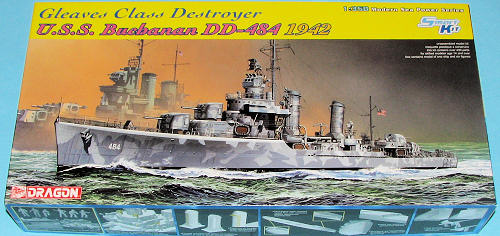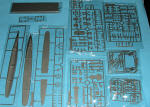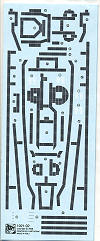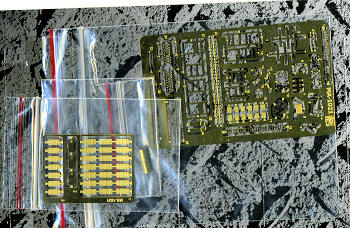
Dragon 1/350 USS Buchanan
| KIT: | Dragon 1/350 USS Buchanan |
| KIT #: | 1021 |
| PRICE: | $ |
| DECALS: | One option |
| REVIEWER: | Scott Van Aken |
| NOTES: | 1942 fit |

| HISTORY |
USS Buchanan, a 1630-ton Gleaves class destroyer, was built at Kearny, New Jersey. Commissioned on 21 March 1942, she transited the Panama Canal a few months later and saw considerable action in the south Pacific during the following two years. During this time, Buchanan participated in the landings on Guadalcanal and Tulagi on 7-9 August 1942, the rescue of survivors of the Battle of Savo Island on 9 August, the Battle of Cape Esperance on 11-12 October, the early phases of the complex Naval Battle of Guadalcanal on 12 November 1942, the invasion of Rendova and New Georgia in June-July 1943, the Battle of Kolombangara on 13 July, the Bougainville campaign in November 1943-January 1944 and the Bismarcks operation in February-March 1944. She was twice damaged in action, on 12 November 1942 and 13 July 1943, and once by grounding on 30 April 1943, but was repaired locally. The destroyer was also credited with sinking the Japanese submarine RO-37 on 22 January 1944.
Following a west coast overhaul, Buchanan took part in the invasion of the Palaus in September-October 1944 and in carrier operations against enemy targets in the Philippines, Formosa and South China Sea areas in December 1944 and January 1945. During the remainder of the Pacific War, she participated in the Iwo Jima operation in February and March, the Okinawa campaign in March-May and strikes by the Fifth Fleets against the Japanese home islands. After Japan capitulated in mid-August, Buchanan operated in support of the surrender ceremonies in Tokyo Bay and the occupation effort.
Buchanan returned to the United States in October 1945 and soon steamed around to the east coast. Decommissioned at Charleston, South Carolina, in May 1946, she remained in the Reserve Fleet for over two years. In preparation for transfer to Turkey, Buchanan was placed back in commission in December 1948 and formally changed hands in late April 1949. She served as the Turkish Navy destroyer Gelibolu until 1976.
USS Buchanan was named in honor of Admiral Franklin Buchanan (1800-1874), who was an important figure in the United States and Confederate States Navies.
| THE KIT |
 Heavily anticipated and equally heavily promoted by flyers in all new Dragon kits, the Dragon USS Buchanan is a kit that has caused a lot of interest, especially amongst ship builders. To this occasional ship constructor, these 1/350 destroyer kits are an excellent balance between size and detail. As much as we'd love to do a battleship in this scale, the truth is that lack of display space often thwarts us. Not the case with this one as it measures just a few inches over a foot in length, about the same as a 1/48 jet fighter.
Heavily anticipated and equally heavily promoted by flyers in all new Dragon kits, the Dragon USS Buchanan is a kit that has caused a lot of interest, especially amongst ship builders. To this occasional ship constructor, these 1/350 destroyer kits are an excellent balance between size and detail. As much as we'd love to do a battleship in this scale, the truth is that lack of display space often thwarts us. Not the case with this one as it measures just a few inches over a foot in length, about the same as a 1/48 jet fighter.  First thing one notices is that the upper hull and main deck are all one piece. In addition, there are transverse supports on the underside to prevent warping. The ship has the ability to be built as a full hull or waterline version and provides a stand with supports for the full hull variant.
First thing one notices is that the upper hull and main deck are all one piece. In addition, there are transverse supports on the underside to prevent warping. The ship has the ability to be built as a full hull or waterline version and provides a stand with supports for the full hull variant.  The two photo etch frets are superbly done as you might expect and include ladders, hatches, prop guards, bridge supports and a myriad of smaller items. A neat addition to the kit are six figures to pose around the decks. Of course, a real ship underway will have more than six crewmembers on the weatherdecks, but these do add some life to things. A stronger than normal paper sheet is provided for various flags. A neat addition to the kit is a decal sheet that is basically strips of non-skid to be placed atop the already-painted deck. Each decal has a specific place on the ship and the instructions annotate this.
The two photo etch frets are superbly done as you might expect and include ladders, hatches, prop guards, bridge supports and a myriad of smaller items. A neat addition to the kit are six figures to pose around the decks. Of course, a real ship underway will have more than six crewmembers on the weatherdecks, but these do add some life to things. A stronger than normal paper sheet is provided for various flags. A neat addition to the kit is a decal sheet that is basically strips of non-skid to be placed atop the already-painted deck. Each decal has a specific place on the ship and the instructions annotate this.| CONCLUSIONS |
| REFERENCES |
June 2008
If you would like your product reviewed fairly and fairly quickly, please contact the editor or see other details in the Note to Contributors.
Back to the Previews Index Page